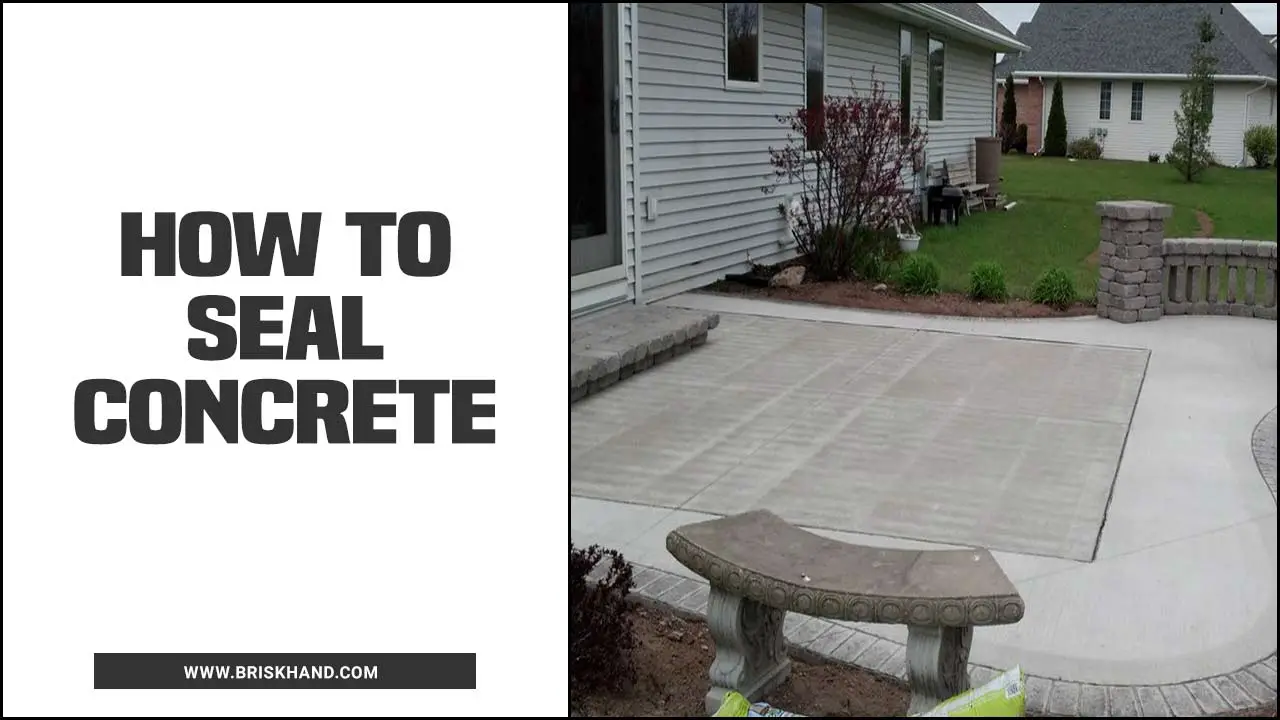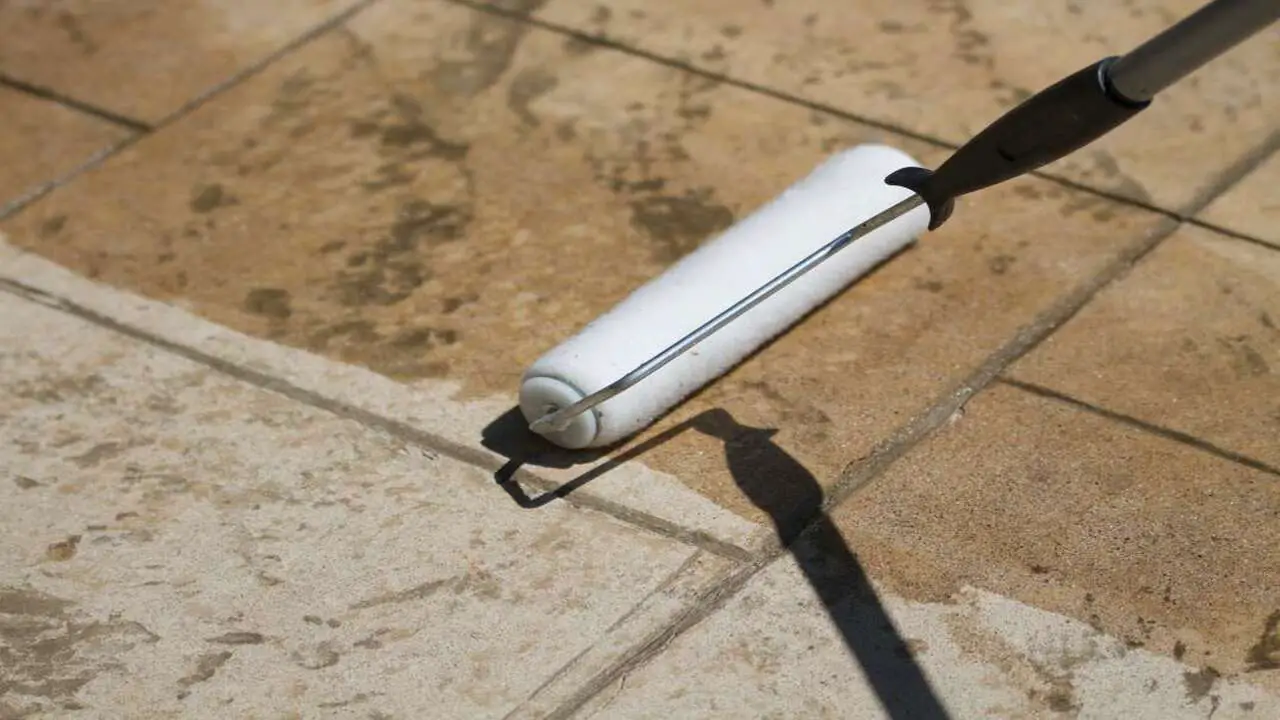Concrete surfaces are durable and offer a sleek and polished look to any space. However, concrete is a porous material that can easily absorb moisture and stains if not sealed properly.
Sealing concrete is a crucial step in maintaining its appearance and longevity. Proper sealing can prevent damage from weather, spills, and wear and tear, whether it’s a concrete driveway, patio, or floor.
Here we’ll provide a step-by-step guide on how to seal concrete. We’ll also cover different application areas for sealed concrete and how to maintain it over time. So, whether you’re looking to protect your concrete patio or basement floor, keep reading to learn everything you need about sealing concrete for long-lasting protection.

Signs Your Concrete Needs Sealing
Knowing when to seal your concrete is crucial in maintaining its longevity and durability. Here are some signs that indicate your concrete may need sealing. By watching for these signs, you can ensure that your concrete remains in optimal condition and avoid costly repairs in the future.
- Water absorption: If water quickly soaks into the concrete rather than beading up on the surface, it is a sign that it is porous and needs sealing.
- Discoloration and staining: If you notice dark spots or discoloration on your concrete, it could indicate oil, grease, or other substances penetrating the surface. Sealing can help prevent further staining.
- Cracks and spalling: Concrete that has cracks or is starting to chip and flake (spall) may benefit from sealing to protect it from further damage caused by moisture infiltration.
- Fading color: If the color of your concrete has faded significantly due to exposure to sunlight, sealing can help restore and protect its original appearance.
How To Seal Concrete For Long-Lasting Protection

To ensure a successful concrete sealing process, follow this step-by-step guide. Begin by thoroughly cleaning the surface and removing any grease or stains. Choose a suitable day with optimal temperature for the best results. Apply the sealant in thin coats to allow for better adhesion and coverage.
Let each coat dry completely before adding the next one. It is important to follow the specific instructions the sealant product provides to ensure optimal sealing. By following these steps, homeowners can achieve long-lasting protection for their concrete surfaces. Below we discuss more in detail on how to seal concrete.
Choosing The Right Day And Temperature For Sealing

When preparing to seal concrete, choosing the right day and temperature is important for optimal results. Check the weather forecast and aim for a dry day without rain. The best temperature range for sealing is between 50-90 degrees Fahrenheit. Avoid sealing on extremely hot or cold days, as this can affect curing.
Additionally, sealing in direct sunlight should be avoided, as it can cause the sealer to dry too quickly. Consider the humidity levels, as high humidity can impact the curing process. Remember these factors to ensure a successful sealing process.
Cleaning The Surface Before Sealing
To ensure a successful sealing process, cleaning the concrete surface thoroughly is important. Remove any debris, dirt, or stains that may be present. This can be done using a pressure washer or a scrub brush for more stubborn areas. For deep-seated stains or discoloration, an etching solution can be used. Once the surface is clean, allowing it to dry completely before applying the sealant is crucial. Additionally, take the time to repair any cracks or damage to ensure the best adhesion of the sealant.
Applying The Sealant
To ensure a successful sealing process, knowing how to apply the sealant correctly is important. Start using a sprayer or roller to distribute the sealant onto the concrete surface evenly. Apply thin coats to avoid pooling or bubbling, working in small sections and applying in opposite directions for uniform coverage. Don’t forget to cover all areas, including edges and corners. If additional protection is needed, apply a second coat.
This will help to seal the concrete, protect it from grease, oil stains, and abrasion, and provide the best adhesion for long-lasting results. Homeowners should also consider using topical sealers such as silicones, silanes, or siloxanes for outdoor applications, as they can penetrate the pores of the concrete, providing excellent waterproofing capabilities.
Letting The Sealant Cure
After applying the sealant to the concrete surface, it is essential to let it cure for the recommended time mentioned on the product. During this time, avoiding foot traffic or other activities on the sealed surface is crucial to allow the sealant to set properly.
Additionally, it is important to keep the area dry and protected from moisture during the curing process. The curing time can vary depending on the type of sealant used. Before regular use, it is advisable to test the cured surface for adhesion and durability to ensure the best results.
Different Areas Of Application For Sealing Concrete

Sealing concrete driveways and patios provides protection against stains and oil spills. It helps in preventing moisture intrusion for concrete floors and basements. Exterior concrete surfaces can be protected from weathering and discoloration through sealing, while interior concrete surfaces can be enhanced in terms of durability and ease of cleaning.
Different types of sealers are available for specific applications, ensuring the best adhesion and waterproofing. Homeowners can choose the appropriate sealer based on the square feet they need to cover, with options such as topical sealers, silanes, siloxanes, and silicone sealants commonly used for outdoor applications.
Sealing Concrete Driveways And Patios
When sealing concrete driveways and patios, it is important to use a penetrating sealer that creates a chemical barrier against stains and moisture. To enhance the appearance, consider using a concrete sealer with color options. Applying the sealer evenly with a roller or sprayer ensures consistent coverage.
Sealing new concrete driveways and patios is advisable only after they have fully cured. To maintain the protection, reapply the sealant every few years. This helps in preventing cracks and preserving the longevity of the concrete surface.
Sealing Concrete Floors And Basements
For durable protection against moisture, consider using epoxy or polyurethane sealers. Before applying the sealant, make sure to clean and prepare the surface. Apply thin coats of sealant using a roller or sprayer for optimal coverage. It is important to allow the sealant to cure completely before using the floor or basement. To prevent cracks or damage, regularly inspect and maintain the sealed surface. Remember, proper maintenance is crucial for long-lasting protection.
How To Maintain Sealed Concrete?

Maintaining sealed concrete is essential to prolonging its durability and appearance. Here are some tips to help you keep your sealed concrete in top condition. Following these maintenance tips ensures that your sealed concrete remains in excellent condition for years.
- Regular cleaning: Regularly sweep or use a soft-bristle broom to remove dirt and debris from the surface. Avoid using abrasive cleaners or tools that can damage the sealant.
- Spill management: Promptly clean up any spills to prevent staining. Use a mild detergent and water solution to clean the affected area, and rinse thoroughly.
- Avoid harsh chemicals: Harsh chemicals, such as bleach or ammonia-based cleaners, can degrade the sealant over time. Stick to mild cleaning solutions specifically designed for sealed concrete.
- Protect against heavy objects: Place furniture pads or coasters under heavy objects to prevent scratches or indentations on the sealed surface.
- Reapply sealant as needed: Over time, the sealant may wear off due to foot traffic and exposure to the elements. Follow the manufacturer’s recommendations for reapplying sealant to maintain optimal protection.
Preventing And Repairing Cracks In Sealed Concrete
It is important to take certain steps to prevent and repair cracks in sealed concrete. Before sealing the concrete, install expansion joints as a control measure against cracking. Additionally, fill any existing cracks with a suitable filler before applying the sealant.
Regularly inspect the sealed surface for new cracks and promptly repair them using a concrete repair product. Finally, follow proper curing and maintenance practices to prevent future cracks. Following these steps, homeowners can ensure their sealed concrete remains crack-free and well-maintained.
Conclusion
Sealing concrete is important in protecting it from damage and extending its lifespan. Applying a sealant can help prevent stains, cracks, and deterioration caused by moisture and other external factors, whether you have a concrete driveway, patio, or floor. Following the steps outlined in this blog, you can effectively seal your concrete surfaces and ensure their durability for years. Remember to choose the right type of sealant for your specific needs and always follow the manufacturer’s instructions. Hopefully, now you understand how to seal concrete.
Frequently Asked Questions
1.Can Old Concrete Be Effectively Sealed?
Ans: Old concrete can indeed be effectively sealed with the right products and techniques. Before sealing, it’s important to clean the concrete and repair any cracks or damage thoroughly. For older concrete, a penetrating sealer is recommended to ensure proper adhesion.
2.Does The Concrete Need To Be Sealed?
Ans: Concrete should be sealed to protect it from water damage, stains, and other forms of deterioration. Sealing concrete can extend its lifespan and improve its overall appearance. Different types of sealers are available, including acrylic, epoxy, and penetrating sealers.
3.How Long Do You Wait To Seal Concrete After Its Poured?
Ans: It is crucial to allow at least 28 days for the concrete to fully cure and dry before sealing it. Additional drying time may be needed if the concrete has been exposed to moisture or rain. Always follow the manufacturer’s recommendations for application and drying times.
4.Is It OK To Seal Old Concrete?
Ans: Sealing old concrete is not only possible but also beneficial. It helps prevent further damage and extends the lifespan of the concrete. Before sealing, make sure to clean and repair any necessary areas thoroughly. Consulting a professional for guidance on the best sealer is recommended.
5.Should You Wash Concrete Before Sealing?
Ans: It is crucial to wash the concrete before sealing it. This step removes dirt and debris, ensuring proper adhesion of the sealant. Use a pressure washer or scrub brush with detergent for a thorough cleaning. Allow the concrete to dry completely before applying any sealant.

I am passionate about tools and electric work. I love finding new tools and experimenting with them.

